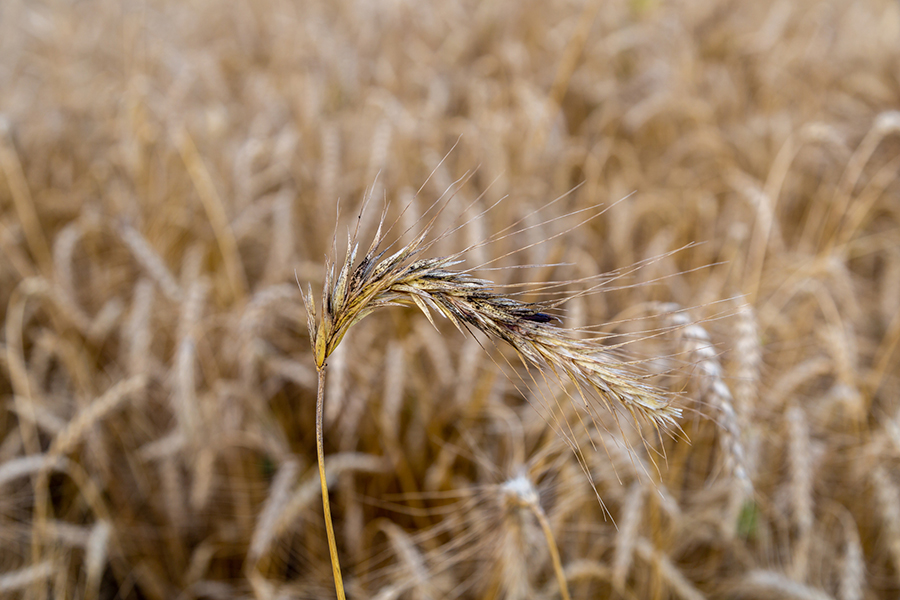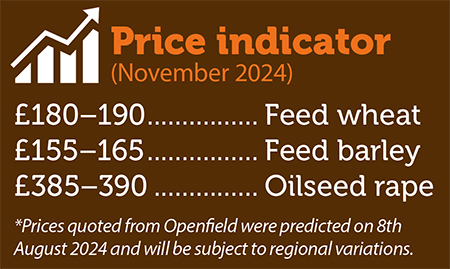Remember – any type of ergot counts when it comes to rejections
23rd August 2024
With some colour sorters struggling to identify modern grass ergot, it’s time for everyone to find a solution to this problem.

As soon as harvest kicked off, we all waited apprehensively to see what curve balls it brought with it. Unfortunately, the word ergot is being heard too much already. We seem to have lived in its shadow for the last three or so years, but with little or no improvement.
There seem to be more colour sorters available, but at what point does the market become paralysed because all grain on farm exceeds the contractual requirements of zero or max 0.001% by weight for feed grains? So asks Cecilia Pryce, Openfield’s head of research, compliance and shipping.
The issue doesn’t stop there, because much of the modern ergot is not the big, black, chunky wheat and rye ergot, but grass ergots – these are the thin lines of black, almost like thin nail clippings, which some colour sorters struggle to identify. Please remember that any type of ergot counts, as it has the same toxic properties and will result in rejections.

A typical cereal ergot can weigh between 0.035–0.05g and as such, if one piece was found in a kilo sample, that would exceed the 0.001% by weight. Giving a result ranging from 0.0035–0.005%. Similarly, a grass ergot can weigh around 0.0059g, which would result in a percentage by weight in a 1kg sample of 0.00059% – meaning that more than two and you would be exceeding the limit. I strongly believe it’s time for everyone to find a solution to this problem.
Some farmers never see the problem, expecting to see only big black lumps rather than skinny grass ergot, so please don’t be one of those – dig deep in your grain piles and look very closely. With the increased amount of farm-saved seed and the current problem with heavy black-grass matched with min till, many will tell you it’s here to stay; but there must be a way to encourage clean crops. The same issue is likely to be felt regarding mycotoxins in dirty crops, which ultimately could mean that some farmers struggle to market their commodities.
We are all ruled by legislation and contracts. Ex-farm grains must comply with them when entering the first consumption point where they will be and are tested. Now is the time to think how you can change things for harvest 2025. It’s tough, but investing in clean crops and fields could prove a cheaper alternative to claims, rejections, professional cleaning – and the high blood pressure and bad temper that go with them.
Payments for bulk samples
The UK Grain Testing Network is currently willing to pay farmers to send them bulk samples of oats and beans at £28.50 for each usable bulk sample. The team will use these samples to ring check hundreds of grain testing machines across the entire industry to ensure all grain testing equipment is calibrated and accurate for growers, merchants, and end users such as millers, maltsters, and distillers right across the UK. All this ensures better standards and consistency right across the industry.
They would like you to send them bulk samples of 40kg beans and/or 60kg of oats. If you would like to be paid to fill up some bulk sample bags, please email paul.allison@sciantec.uk.com who will supply you with sacks, arrange collection and pay you £28.50 for each usable bulk sample.
Fertiliser matters
Post-harvest is an important time to think about the vital nutrients that have potentially been removed during this process, including phosphate and potash, that will need to be replaced to ensure the following crop has adequate supply, writes Openfield fertiliser manager Lucy Hassall.
With establishment being the most critical period, autumn applications of PK enable these nutrients to be worked into seedbeds to supply the crop during growth. Potassium facilitates optimum water regulation throughout the plant.
Maintaining enough water in cells generates turgor pressure, creating strong building blocks for a robust plant. Phosphate plays an important role in energy transfer within the plant, and in early growth stages, promotes root development, which is also important for efficient uptake of other nutrients.
PK grades can be tailormade to the crop’s requirements from soil sample results, along with the option of protected phosphate and the addition of micronutrients such as manganese, which is crucial for enzyme activation and functions, particularly those related to respiration, photosynthesis, and nitrogen metabolism.
Read more arable news


